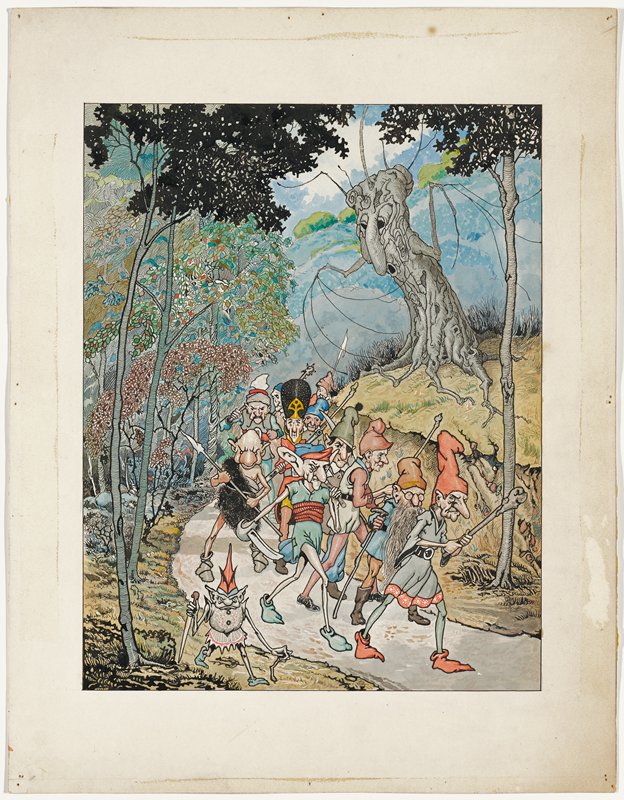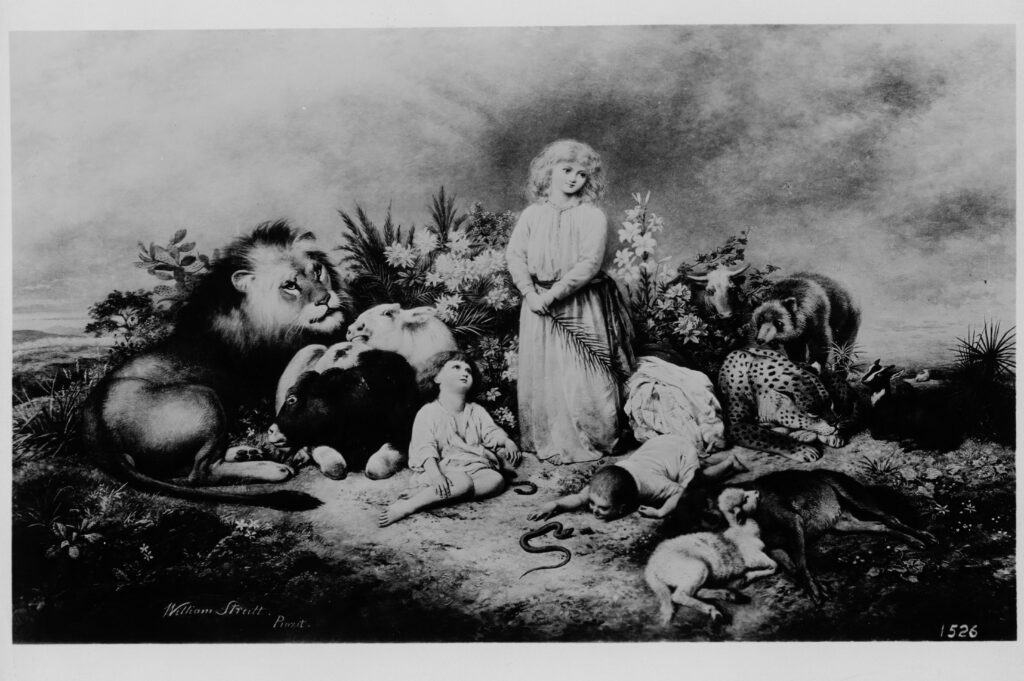The Elves of the Forest Centre
By Pansy [1]
Annotations by Maggie Kelly

There lived a little girl, named Maia, with her mother, in a deep forest. As they had always dwelt in the same lone spot, the child had become accustomed to the solitude of the surrounding woods, and even loved the old trees that towered above her head.
So she was not surprised when, one bright morning, her mother said: “Maia, take thy little basket, and go to the forest centre, and fetch a few fagots and some nuts.”
Maia quickly put on her gipsy hat, bade her mother good-bye, and tripped away. She knew all the little birds and squirrels; she did not fear even the king of beasts, so gentle was he to her. And oh! when the young tigers leaped forth to meet her, she could not help setting her basket down, to take a nice tumble upon the soft moss. Then the old tiger and tigress came home, bringing four little lions to spend the day. So they carried Maia on their backs by turn, until they reached the forest centre, then, wagging their tails, they left her, all alone.
Hark! a rustling among the dry branches—only the wind or a squirrel in its nest—Maia began to fill her basket from a store of nuts, hidden in a hollow stump, and to tie up her fagots, for she must hasten; but soon she dropped her basket, the fagots were forgotten, for there, before her, were the little Elves of the forest; yes, the dear funny little Elves, whose history her mother had so often told her.
A little Elfin maid stole to her side, to see what she might be, and Maia was half tempted to seize the tiny creature, but something bade her not, so she only said: “Oh, how beautiful thou art!” At this the little Elf darted away, but soon returned to say: “Our king desires thee to come and feast with us, oh! great giantess!”
Maia, quite bewildered, followed the little maid, and soon found herself in the presence of the Elfin king, a tiny fellow, about as tall as her hand, and dressed in a robe of crimson velvet, spangled with diamonds. As she began to blush and courtesy, he said: “Maia, thou art a good child; we have watched thee, day by day; all the beasts of the forest love thee. They say, ‘So kind and gentle is little Maia, that we would not harm her.’ We, too, love, and will befriend, thee.”

He paused, and a little Elf came forth to dance. When the dance was finished, Maia sang a song about the Elves, which pleased the king very much; then all sat down to the banquet, which was composed of the most delicate food ever known. When all were done feasting, the Elves sang another song, after which Maia was again called by the king: “Here,” he said, leading forward the Elfin maid whom she had before met, “here is a little one for thee; guard her well, and she will be a faithful friend.”
“How can I repay thy kindness?” cried Maia; but before she could say more, she found herself in a beautiful little carriage, drawn by twelve robins, and at her side sat the maiden Elfletta, given her by the king. Soon she arrived at home, where she had long been expected; but where was the basket of nuts? where the fagots? Elfletta soon answered that question, by pointing to another Elf, who was seen in the distance, bringing them, and many other nice things.
But this good fortune did not make Maia forget her duties, and I am sure she set a good example for Elfletta, by rising early, and cheerfully performing her labors. At the forest centre the Elves were always glad to see her, and the tigers always glad to carry her there.
When she grew older, the little Elfin maid found a little Elfin man, and, as they loved each other, they were married. Then Maia’s good old mother died, blessing the dear daughter who had been a comfort to her in all her trials. And when Maia found grey hairs among her own dark tresses—when her hand failed, and she grew old and feeble, there had sprung up around her a little family of Elves—then did they befriend her, and she loved them more than ever.
Her eyes grew dim, she lay down to rest, and with her last breath blessed the little Elves. Upon the bed lay a cold form, with a calm smile upon the face; the heart did not beat, the eyes were fixed, the old woman was at rest, but was she there? No; in the sky were a host of angels—they bore the soul of Maia to its heavenly home.
Seward, Frances. “The Elves of the Forest Centre.” Merry’s Museum 35 (January 1858): 11.
[1] Pansy was the pen name for Frances (Fanny) Adeline Seward, who wrote several pieces for the children’s literary magazine Robert Merry’s Museum. Seward was 13 when this story was published.
Contexts
This piece is a selection from Robert Merry’s Museum, a popular children’s literary magazine in the 19th century. Samuel Griswold Goodrich founded it in 1871, and in 1872, the magazine was absorbed by The Youthful Companion.
According to scholar Pat Pflieger, “‘Elves’ is a good example of a ‘Mary Sue,’ an unbelievably amazing character often created by amateur writers.” Click the Mary Sue link to learn more about the history of this archetypal character, often featured in children’s fairy tales.
Resources for Further Study
- Pat Pflieger’s site about 19th-century American children’s literature has a page about this particular literary piece.